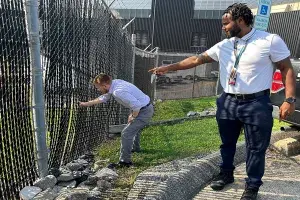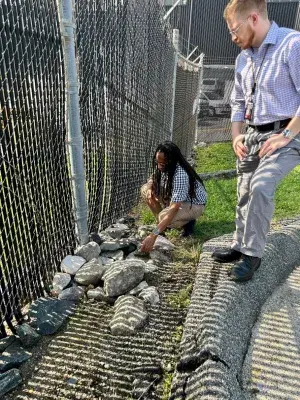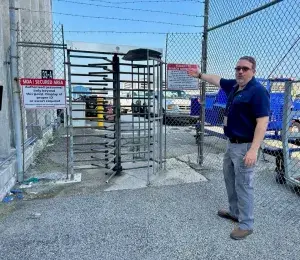
Editor’s note: On a recent hot summer morning, I had the opportunity to shadow a team of TSA inspectors at Baltimore/Washington International Thurgood Marshall Airport as they showed me some of what they do to ensure the 10-mile perimeter of the airport remains secure. Here is some of what I observed and learned.
Every airport is required to have an Airport Security Program (ASP) that outlines how the airport keeps its perimeter secure.
Airports are responsible for their perimeter security. However, it’s the duty of TSA’s transportation security inspectors (TSIs) to identify vulnerabilities and make sure airports comply with TSA regulations. TSIs need to use critical thinking to assess situations, asking many questions along the way.
Are gates locked? Are fences high enough? Is there a clear 10-foot clearance between the fences and trees, vehicles or items stored near fences? Is someone able to socially engineer their way into a building that touches or is next to the air operations area (AOA)? Is there adequate signage to alert passersby that they cannot trespass or go beyond the fence line? Is there a breach in the perimeter that needs to be addressed?
“Inspectors concentrate on four specific areas,” said Baltimore/Washington International Thurgood Marshall Airport (BWI) Supervisory TSI Robert Hoppa. “They are the AOA, the secured area, the sterile area (of the airport where passengers prepare to board flights after going through TSA security) and the public area. As for the perimeter area, a good indicator is the signs. The airport is required to have signage that would indicate it is regulated by TSA.”
TSIs work seven days a week and can conduct inspections any time of the day or night. Not only does their job involve keen observation, but they also may try to socially engineer or talk their way into a secured area of an airport to test security measures.
For example, at BWI, as at other airports, a building may be adjacent to the perimeter, where the entrance to the building fronts a public area such as a sidewalk or parking lot, while the rear of the building sits along the AOA. As a result, the building’s front entrance must remain secure. A TSI might try to socially engineer their way into the building by insisting they need to use a restroom or drop off an envelope for someone inside.
The airport is required to have its security officers drive the perimeter of the airport a certain number of times per day as part of the ASP to maintain perimeter security.
“It all depends on what is included in an airport’s ASP, which is an agreement between the airport and the TSA federal security director (in that region) to ensure adequate security measures are in place to adhere to federal regulatory requirements,” Hoppa said.
An airport perimeter has miles upon miles of fences. In some areas, airports require the fences to reach a certain height with a specific number of barbed wires lining the top of the fence.
An inspector looks to ensure the barbed wires are in place and tight enough to prevent someone from crawling between the wires. They also check to make sure the fences are tight, and in doing so will tug on the fences. They also make sure nobody can crawl under them if water run-off erodes the ground.
“When we do the fence inspections, one of the things we look for is the tightness of the fence to see how loose it is,” Hoppa pointed out as he tugged a section of chain-link fence. “Can someone pull it down? Can you grab it at the bottom and pull it up to allow someone to have access? When we do the actual inspection, we will grab along the fences.
“In some areas, we know the fences get run into by lawnmowers, and the landscapers don’t realize the damage the lawnmowers do. So, when we do an inspection, we actually see what damage has to be corrected. We need the airport to address that vulnerability.”
If inspectors find a violation or an unexpected breach in the fence line, they immediately notify the airport, which is responsible for correcting the problem.
If a car crashes into a fence, the airport is responsible for fixing the fence as soon as possible. Whether it takes a few hours or a few days, the airport is responsible for stationing a guard at that location until the fence is repaired.
If the AOA undergoes construction, a gate may be unlocked or remain open. If so, a guard must be stationed at that entry point to monitor construction workers and vehicles coming in and out of the area to verify they have proper access.
Each airport has its own special challenges, and no two airports are alike. At BWI, huge Amazon warehouses sit along the airport’s AOA. The airport grounds also include wooded areas with an area where firefighters train. A cemetery is also adjacent to the AOA.
No matter the layout of the airport, TSIs play a key role in accomplishing TSA’s mission, performing a full range of security compliance activities to keep travelers and airports secure.
By Lisa Farbstein, TSA Strategic Communications & Public Affairs


